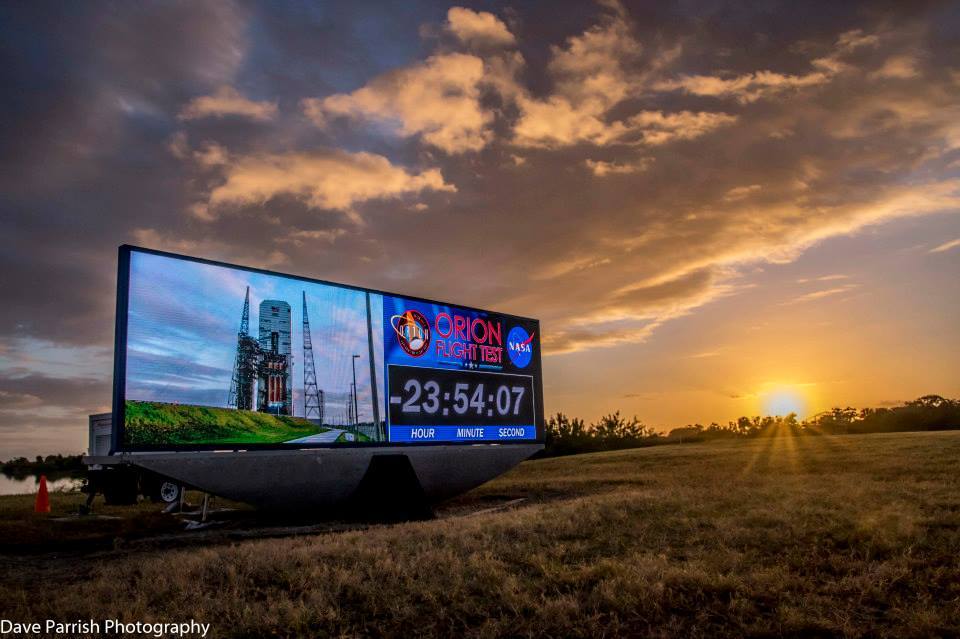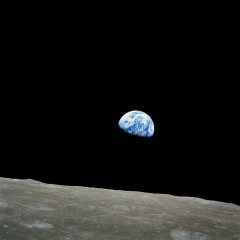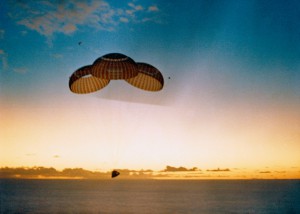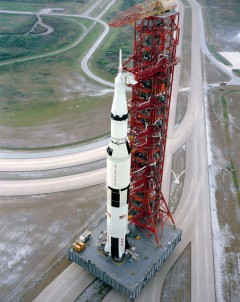
Two days ago, NASA’s Orion spacecraft triumphantly sailed through its maiden shakedown voyage, the Exploration Flight Test (EFT)-1, atop a Delta IV Heavy booster. During its 4.5-hour mission, the vehicle which will someday return humans Beyond Earth Orbit (BEO) for the first time since the Apollo era was delivered twice through the harsh radiation environment of the Lower Van Allen Belt, reaching a peak altitude of 3,600 miles (5,800 km), and put its heat shield to the ultimate test by plunging back through Earth’s atmosphere in excess of 20,000 mph (32,000 km/h), close to what it would experience during a return from lunar distance. Yet, as noted in yesterday’s AmericaSpace history article, many and more of EFT-1’s milestones had been accomplished by the Apollo program in the late 1960s and its perilous descent had been experienced by 24 humans, three of them on more than one occasion.
Although the Gemini XI crew had briefly entered a medium Earth orbit, reaching a maximum apogee of 850 miles (1,370 km) in September 1966, the first humans to depart the gravitational “well” of the Home Planet and enter “cislunar” space were the astronauts of Apollo 8 in December 1968. During that momentous voyage, Frank Borman, Jim Lovell and Bill Anders rode the mighty Saturn V, whose S-IVB third stage was reignited in a so-called Trans-Lunar Injection (TLI) burn to send them on the first piloted circumlunar expedition. Six days later, the three men returned to Earth and their conical command module—so similar in physical appearance to the Crew Module of Orion—experienced heating loads as high as 2,760 degrees Celsius (5,000 degrees Fahrenheit) during re-entry.
Borman and Lovell had both flown 17,500 mph (28,800 km/h) re-entries during the Gemini era, but nothing they had experienced could have prepared them for 21,685 mph (34,900 km/h) return from the Moon. Their re-entry carried them over north-eastern China, then brought Apollo 8 in a long, slanting path towards the south-east. “We were flying upside down, as well as pointing backward,” Borman reflected in his memoir, Countdown. “Deceleration forces were building up to nearly 7 Gs and they stayed there for six minutes.” It would later be determined that the glow of the plasma sheath around the Apollo 8 command module was so bright that a Pan Am pilot reported seeing their passage through the atmosphere, which Borman described as “a white incandescent trail, 100 miles long”.

Within the spacecraft, temperatures were kept at comfortable levels, but Borman was not alone among the Apollo lunar voyagers in having compared his return to Earth as flying inside a neon tube. The maneuverability of Apollo, like Orion, during this period was commanded in a “surprisingly agile” fashion. “Flying the command module had been compared to steering an aircraft carrier with an outboard motor,” wrote Borman, “but I didn’t find it that sluggish, although I wouldn’t have wanted to try a dogfight in it!” Fellow astronaut John Young, who flew two lunar-return re-entries on Apollo 10 in May 1969 and Apollo 16 in April 1972, had the utmost of respect for the spacecraft’s guidance system, which commanded full “lift-up” at 6.8 G, then rolled to 90 degrees at 5.8 G and to 180 degrees at 5.3 G, establishing “lift-down”, whilst continuously monitoring the myriad systems of the command module at such blistering speeds.
One of the most critical aspects of the final stages of an Apollo re-entry, as with EFT-1, was the satisfactory deployment of the trio of red-and-white parachutes, and in the pre-dawn darkness of 27 December 1968 Borman could not at first be certain it the main canopies had been unfurled. The crew of their recovery vessel, USS Yorktown, knew before the astronauts did, and spotted the intermittent flicker of a flashing strobe light, mounted on one of the parachutes.
“We hit harder than anyone expected and a wave of water came surging through the spacecraft, from where we had no idea,” remembered Borman. “I figured a check valve might have been forced open, although NASA engineers later theorized the water was condensation that had gathered on the environmental control system. The landing impact was so jarring, I didn’t move fast enough to pull a switch that fired an explosive cord, releasing the parachutes. Momentarily stunned, I hit the switch too late and the still-attached chutes pulled the spacecraft over, nose-down in the water. So there we were, the three most famous men in the world at this moment, hanging ignominiously head-down by our belts like a trio of harnessed monkeys!” At first, Anders suspected that the hull had cracked, and as the ship went nose-down Borman succumbed to a touch of seasickness. Both Lovell and Anders had served in the Navy and showed no mercy to their Air Force commander. “What do you expect?” they tormented him, “from a West Point ground-pounder?”
The Apollo 8 crew remained in the water for about 90 minutes, until just after dawn, when frogmen were deployed to attach a flotation collar to the uprighted command module and open the hatch. “And I think that may have been the best moment of the mission,” wrote Borman, “to feel the fresh sea air of blessed Earth on my face, realizing the mission was over and successful.”
Five months later, in May 1969, the astronauts of Apollo 10—Tom Stafford, John Young and Gene Cernan—repeated the journey to the Moon, albeit with a lunar module, which they used to accomplish the first Powered Descent to an altitude of just 50,000 feet (15,240 meters) above the surface. Their return to Earth holds the current Guinness-accredited world record for the highest velocity of any human-capable vehicle into the atmosphere, during which they reached 24,791 mph (39,897 km/h). “That speed coverts to Mach 37.52!” Young explained with astonishment in his memoir, Forever Young. It would subsequently be determined that they accelerated back to Earth faster than any other Apollo crew, making the men of Apollo 10 the fastest humans in history. In his own autobiography, The Last Man on the Moon, Cernan remembered an enormous white and violet “ball” of flame, literally sweeping up the sides of the command module, like a glove. “It grew in intensity,” he wrote, “and flew out behind us like the train of a bride’s gown, stretching a hundred yards, then a thousand, then for miles…and the whole time we were being savagely slammed around inside the cabin.”

At one stage, during the entry phase, Cernan even turned to Stafford and asked if they were entering daylight. No, his commander assured him, the bright glow was simply the super-heated plasma surrounding the spacecraft. “I trained a movie camera on the flames and molten matter spewing off the heat shield as we blazed across the sky,” wrote Stafford in his memoir, We Have Capture. “Our descent was caught on a video camera in American Samoa, where we looked like a huge comet with a long trail of fire.”
After the safe return of Apollo 10, the next flight to come back to Earth from lunar distance was Apollo 11 in July 1969, which ferried astronauts Neil Armstrong, Mike Collins and Buzz Aldrin on humanity’s historic first landing mission to the Moon. Although Armstrong and Aldrin’s steps on the Sea of Tranquility were the major accomplishment of the mission, the high-velocity return to the Home Planet—like that of Orion, more than 45 years later—put their command module’s heat shield to the ultimate test. Shortly before Entry Interface, Apollo 11 backup commander Jim Lovell radioed the crew from Mission Control, helpfully advising them to ensure that they entered the atmosphere blunt-end forward. “We are scheduled to hit our entry corridor at an angle of 6.5 degrees below the horizon,” explained Collins in his autobiography, Carrying the Fire. “We are aimed at a spot south-west of Hawaii.” The phenomenal rate of deceleration, he continued, produced a spectacular light show, as the infinite blackness of space was steadily replaced by “a wispy tunnel of colors: subtle lavenders, light blue-greens, little touches of violet, all surrounding a central core of orange-yellow.”
Like the two Apollo crews before them, and the six Apollo crews who would follow at lunar-return velocities, Armstrong, Collins and Aldrin were returning through what could only be compared as the fires of Hell itself. Passing through the worst of the re-entry heating, the astronauts beheld what Orion may have beheld—and certainly what its future crews will behold—as a vast bank of stratocumulus clouds came into view, before being promptly arrested by the sharp jolt of the three main parachutes. After the return of Apollo 11, six more teams of astronauts would endure the perilous descent through the atmosphere at lunar-return velocity, including the unlucky crew of Apollo 13 in April 1970, who suffered an explosion within their service module and a hairy journey back to Earth. Although Jim Lovell—the first man to experience two re-entries from lunar distance—and his crewmates Jack Swigert and Fred Haise survived the mission, they descended to Earth at a slightly different angle than predicted. This caused an unexpectedly lengthy period of communications blackout, immortalized in Ron Howard’s 1995 movie, Apollo 13.
More than four decades since the last humans returned from a BEO destination, it is remarkable to listen to the voices of the Apollo astronauts and their recollections of what it “felt” like to hit the upper atmosphere at such enormous velocities. Apollo 15’s Jim Irwin, returning to Earth with Dave Scott and Al Worden in August 1971, was particularly taken aback by the intensity of the fireball and the loss of communications with Mission Control. “You look out the window and there is just this beautiful orange-yellow glow,” he wrote in his memoir, To Rule the Night. “You also have the glow of ionized particles that are streaming out behind the spacecraft.” As Worden—recently interviewed by AmericaSpace’s Emily Carney—and Scott monitored the command module’s systems, Irwin positioned cameras in the windows to acquire imagery of the re-entry. As they descended further into the sensible atmosphere, he began to discern the deep blue of the Pacific Ocean, the whites of cloud-tops and, at length, his first glimpse of land: the snow-capped peaks of New Zealand.

Unfortunately for the Apollo 15 crew, one of their command module’s trio of main parachutes failed to deploy properly and threatened to give them a hard landing. As described in AmericaSpace’s recent Orion history series, the ability of the next-generation BEO vehicle to land in such difficult circumstances was exhaustively tested during its development. “The drogue chutes came out at 25,000 feet (7,600 meters),” Irwin recalled, “and that really slowed us down, just like a drag chute or speed brakes on an airplane. It doesn’t jerk you, it brakes you. Then you start oscillating wildly underneath the drogues. Just before you get to 10,000 feet (3,000 meters), the drogues are released. You can see up there; you see them go, and then you feel them go. You free-fall for a few seconds, wondering whether the main chutes are going to come out. At 10,000 feet, the main chutes are out and they slow you almost completely. We saw three chutes; then we saw that one had failed. It just collapsed. Well, Al saw it and I saw it and at the same time the helicopter crews…told us we had lost a chute.”
Splashing down until two canopies was hard, but within tolerances. Several weeks later, NASA revealed that the most likely cause of the failure was a dump of Monomethyl Hydrazine (MMH) from the Reaction Control System (RCS). On previous missions, the dumped MMH was vented and harmlessly lost in the wind, but on Apollo 15 the calm weather conditions sent it directly “upwards” and into the parachute. In Al Worden’s mind, the crew was just unlucky in that they landed on such a very calm day. “As we released this [MMH],” he recounted later, “it went right up into that chute and the chute just dissolved. I think it was probably the first time that it happened in the program, because I think on every other flight there had been some surface wind that [moved] the spacecraft.” He added that if the command module had taken longer to descend, it might have similarly affected one of the other two parachutes.
The final two piloted missions to return from the Moon did so without major incident, although John Young—who became the second person to record two re-entries from lunar distance, as commander of Apollo 16—reflected in Forever Young that the wind in the three main parachutes dragged the command module into a nose-down “Stable 2” orientation in the Pacific Ocean. “We hit the water “flat”,” he wrote, “and the net effect was a much harder impact than I recalled from Apollo 10.” Immediately, his crewmates Ken Mattingly and Charlie Duke set to work jettisoning the canopies and inflating the command module’s flotation bags in an effort to establish themselves into an upright “Stable 1” position. “That took about 4.5 minutes,” Young continued, “and it seemed like forever before the command module got upright. Even then, it didn’t get fully upright into the Stable 1 position. Post-flight inspection showed that the uprighting bag located at the center-bottom of the capsule had only partially inflated.” Similar flotation and uprighting capabilities were evaluated during repeated water tests of Orion and were demonstrated with great success at the end of the EFT-1 mission.
Eight months after the return of Young’s crew, in December 1972, the astronauts of Apollo 17—Gene Cernan, Ron Evans and Jack Schmitt—became humanity’s most recent emissaries beyond low-Earth orbit. Their achievement meant that Jim Lovell, John Young and Gene Cernan currently stand as the only individuals in human history to have performed at atmospheric re-entry from lunar distance on as many as two occasions, with Frank Borman, Bill Anders, Tom Stafford, Neil Armstrong, Mike Collins, Buzz Aldrin, Pete Conrad, Dick Gordon, Al Bean, Jack Swigert, Fred Haise, Al Shepard, Stu Roosa, Ed Mitchell, Dave Scott, Al Worden, Jim Irwin, Ken Mattingly, Charlie Duke, Ron Evans and Jack Schmitt having accomplished one apiece.
No one has been to the Moon since. Indeed, no one has journeyed through and beyond the Van Allen Belts since or entered cislunar space. Depressingly, the highest altitude to which humans have traveled since the Apollo era is about 350 miles (560 km), during the initial Hubble Space Telescope (HST) deployment mission in April 1990 and five dedicated servicing flights to the iconic observatory between December 1993 and May 2009. A minimum of four years will now ensue before the next Orion spacecraft voyages into the heavens, again unpiloted, on the first circumlunar expedition by a human-rated vehicle, though no sooner than November 2018. That mission will depart Earth atop the maiden flight of the Space Launch System (SLS) and despite the paucity of crewed Orion opportunities in the years thereafter, it can be hoped that at some point in the not too distant future Americans will again ride their own spacecraft to destinations far from Earth.
This is part of a series of history articles, which will appear each weekend, barring any major news stories. Next week’s article will focus on the 15th anniversary of STS-103, the third Hubble Space Telescope (HST) servicing mission, which became the only shuttle flight to spend Christmas in orbit.
Want to keep up-to-date with all things space? Be sure to “Like” AmericaSpace on Facebook and follow us on Twitter: @AmericaSpace
Missions » SLS » Missions » SLS » EFT-1 » Missions » Apollo »



Ben: excellent account of Apollo re-entries with much interesting detail. Any information regarding (1)the ambient noise the astronauts heard during re-entry, (2) the amount of buffeting the command module may have experienced before drogue and main parachute deployment or (3) the astronauts’ sensation of speed while hitting the atmosphere at 25,000 mph?
Thank you.